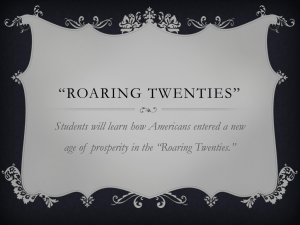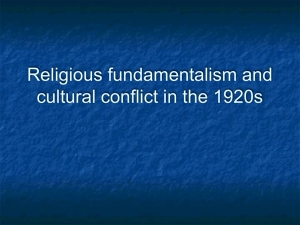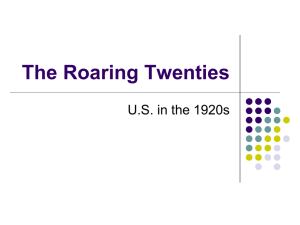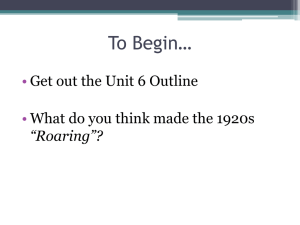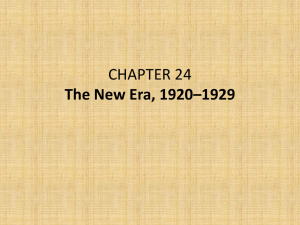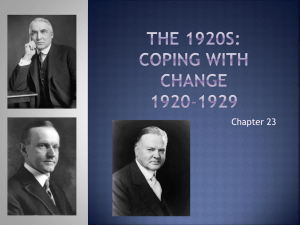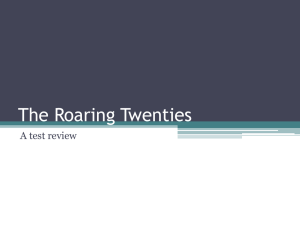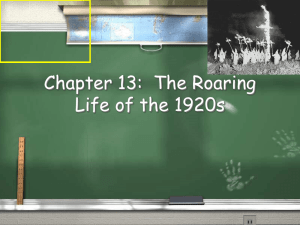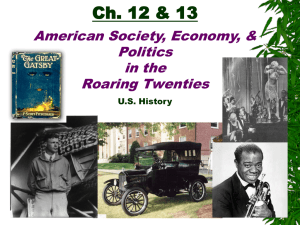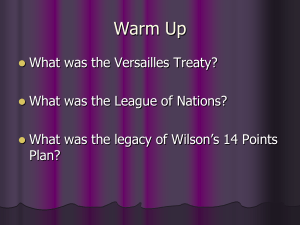1920s Powerpoint 1920s_Powerpoint Phillips
advertisement
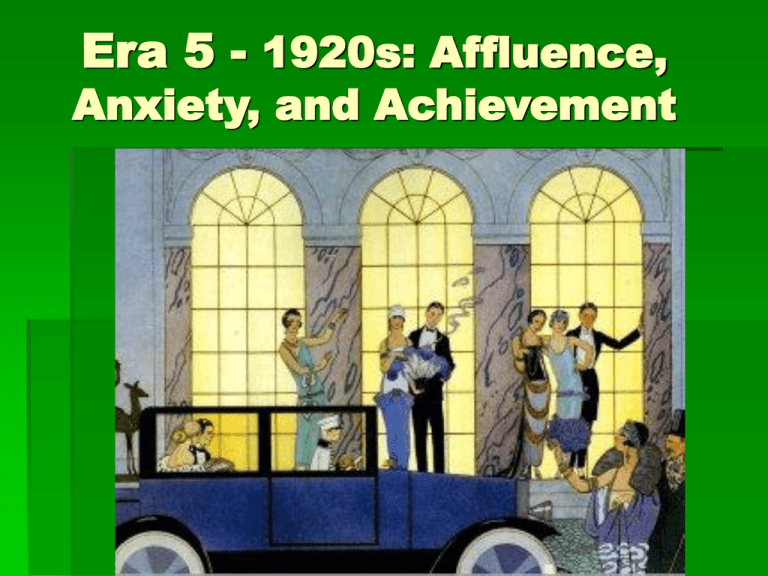
Era 5 - 1920s: Affluence, Anxiety, and Achievement I. Postwar Problems The Red Scare RED SCARE = A TIME PERIOD OF FEAR OF COMMUNISM COMMUNISM = A POLITICAL SYSTEM IN WHICH AN AUHTORITARIAN GOVERNMENT CONTROLS THE MEANS OF PRODUCTION (FACTORIES) AND DISTRIBUTES WEALTH EQUALLY. Philosopher Karl Marx thought that a worker revolution would overthrow capitalism and result in communism. Red Scare (con’t.) As a result of the Russian Revolution, Americans imagined Communists as the worst possible threat to their way of life The ideals of Socialism and Communism were tied, often erroneously, to the American labor movement Strikes increased and the government responded with a series of raids by a young J. Edgar Hoover to round up suspected subversives and radicals Labor troubles worried Americans, who thought that Communism would soon follow Americans thought “Reds” or Communists would sneak into the USA 1919 – Philadelphia Inquirer, Morgan “Put them out and keep them out.” The Sacco & Vanzetti Case 1920 Massachusetts Robbery Two Anarchist, Pro-Labor, Italian immigrants, Sacco and Vanzetti, picked up for the crime Trial did not prove guilt, but found guilty anyway (because of anarchist political beliefs) Police and legal system thought to have been corrupt Executed 1927, after many failed appeals, workers all over the world demonstrated on their behalf. Bartolomeo Vanzetti and Nicola Sacco Nativism Hand-in-hand with the Red Scare was Nativism – favoring people born in the USA and discriminating against immigrants This led to the Immigration Act of 1921 which set quotas for how many people could immigrate to the USA from a certain country These quotas were based upon first-wave immigration and discriminated against South and East Europeans Would immigrants bring communism with them? The labor and communist troubles of the era began to influence those who favored restriction upon new immigrants, many of which were sympathetic to the views of unions and communists. The Ku Klux Klan Reemerged in 1919, after its hibernation since Grant’s Reconstruction crack-down Reconstruction Klan accepted almost anyone, 1920s Klan was thoroughly antiforeign, anti-Semitic, and anti-Catholic as well as racist Endorsed immigration restrictions and prohibition, Opposed flappers and evolution Especially motivated to keep black Americans “in their place” 1920s KKK in West Virginia KKK March in D.C. II. A Prospering Economy The Rising Standard of Living Americans are now the wealthiest people in the world and engaged in CONSUMERISM – A GREATER CONSUMPTION OF GOODS Americans of the post-war years had more leisure time and a shorter work week (thanks to unions) Educational opportunities expanded for some people Corporate mergers began to increase again, with an emphasis on professional management and employee care The Automobile Culture By the 1920s, one in four people had a car The manufacture of the automobile underwent enormous growth in the postwar years, stimulating the rubber, steel, and petroleum industries The growing affordability of the auto forced governments to pave more streets with federal assistance The auto contributed to the creation of city suburbs and rampant pollution A Sunday Drive… A Communications Revolution During the 1920s, the number of homes with telephones increased from 9 to 13 million Radio and motion pictures began to solidify a shared identity of Americans through entertainment, news, and sports Cities Also Grew in the 1920s as More and More People Left the Farm and Moved to the City III. Hopes Raised, Promises Deferred Women Women were joining the workforce in larger numbers (about 1 in 4 women worked) Women had just earned the right to vote Young women were challenging traditional roles by: Working & living on own Wearing short (knee-length) flapper dresses Cutting hair short Wearing make-up Flapper – Called “flapper” because beads on dress flapped around while dancing the “Charleston” Religious Fundamentalism Many of the religious faithful saw a major spiritual crisis in the sweeping changes of the 1920s CHRISTIAN FUNDAMENTALISM – THE BELIEF THAT THE BIBLE IS LITERALLY TRUE AND MUST BE OBEYED, socially conservative survived the era of sophistication, modernization, and change Radio spread the message of the fundamentalist preachers and attracted numerous converts to those ministers who could readily adapt to the new communications technology Scopes Monkey Trial One example of religious fundamentalism was the Scopes Monkey Trial – a court case that put a Tennessee teacher on trial for teaching Darwin’s new theories of evolution (against the law in many southern states) Two great lawyers of the time argued the case: William Jennings Bryan (3-time Pres. Candidate, Sec of State under Wilson) Clarence Darrow – great criminal lawyer – wanted to “put Bryan in his place as a bigot” Judge ruled in favor of the school district and said teachers could not teach evolution However, Darrow won the public’s favor Football coach, biology teacher, John Scopes, agree to be arrested in order to put the law to the test Lawyers Bryan and Darrow Court case attracted tons of attention Rhea County Courthouse, Tennessee, July 1925 Rural America in the 1920s American farmers, as a rule, did not share in the prosperity of the 1920s. When WWI ended, Europe started growing own food again – Americans were now overproducing A vicious cycle of overproduction to meet demands continually lowered market prices of produce, forcing many farmers into the poorhouse Advancements in agriculture (pesticides and advanced fertilizers) increased yield per acre and put many farmers out of business Poor conditions for farmers was another reason why urbanization increased in the 1920s IV. The Business of Politics Global Expansion The 1920s was a decade of dramatic expansion in business, finance, and trade for the United States Continued involvement in the affairs of Central and South America to protect American investments and bring allies into leadership positions But USA was also trying to be a better neighbor and improve relationships with Mexico and other Latin American countries (remove Roosevelt Corollary to Monroe Doctrine) USA was isolationist after WWI Booming Business President Calvin Coolidge declares that “America’s Business is Business!” Consumerism Increased – More people could afford to buy products, so more people were employed to make products People even had money to invest in the Stock Market – they’d buy on MARGIN (pay 10% of the price in cash, then pay the rest later, after the stock value increased) President Calvin Coolidge 1923 – 1929 (took over when President Harding died on his way home from Alaska) Stock Market Crash The prosperity of the decade came to a screeching halt in 1929 with the collapse of the nation’s stock market Many investors had responded to the booming economy by buying stocks on margin (borrowing to invest). An overextension of the market caused a crash with a represented loss of over $26 million on paper Dow Jones Value Value had been at 100 in 1926, Maxed out at 381 Sept. 3, 1926, Crashed Oct. 24, 1929 and eventually fell down to 145 by November 1929 (-62%). Chaos of Oct. 24, 1929 Stock Market Crash, Outside NY Stock Exchange V. 1920s Culture Literature of 1920s Provides Social Commentary F. Scott Fitzgerald questions consumerism and high society in “The Great Gatsby.” It is a good characterization of the 1920s. Ernest Hemingway writes about WWI experiences in “A Farewell to Arms.” African-American Authors Also Critique Society: Part of Harlem Renaissance Harlem Renaissance – blossoming of African-American social thought and culture centered in Harlem, NYC in the 1920s Authors, Artists, Musicians, Historians, Political Thinkers, Dancers, Actors, and Playwrights African American Culture Became More Mainstream and Influenced American Society Greatly Harlem Renaissance Authors Langston Hughes – Poet Celebrated African American culture as well as pointed out how African Americans were not sharing in the prosperity of the 1920s, most famous: Dream Deferred Zora Neale Hurston – Writer Focused on African American folktales and wrote in southern dialect - most famous: Their Eyes Were Watching God (not published until 1937) Langston Hughes and Zora Neale Hurston Jazz = The Music of the 1920s JAZZ: a lively style of music characterized by a strong but flexible rhythm with improvisations on basic tunes and chord patterns Jazz reflected positive spirit of the 1920s Inspired new dances, like the Charleston Louis Armstrong – amazing trumpeter Bessie Smith – talented singer George Gershwin – wrote musical scores for Broadway as well as songs Louis Armstrong, Bessie Smith, George Gershwin VI. Prohibition & Criminal Gangs Prohibition PROHIBITION = made transporting and consuming alcohol illegal (18th Amendment, 1919) Why? Progressives wanted to combat crime, family violence, and poverty Results? Bootlegging = Making, selling, or transporting alcoholic liquor for sale illegally. Organized Crime = Controls Illegal Liquor Sales, Has Gang Wars over Territory Trying to Enforce Prohibition Al Capone Ran a criminal gang in Chicago Made about $60 million from illegal liquor sales, $25 million from illegal gambling, and $20,000,000 elsewhere Bribed police to keep in business Responsible for St. Valentine’s Day Massacre of Six Members of the Bugs Moran Gang (1929) Gov’t Finally Convicted Him of Tax Fraud in 1931 – 11 years sentence Al Capone Prohibition Results Positives: Decrease in alcoholism and alcohol-related deaths Negatives: Criminal Gangs, Violence Gov’t Can’t Enforce It 21st Amendment – Ends Prohibition (1933) VII. Achievements Charles Lindbergh May 20-21,1927: First solo-flight across the Atlantic Ocean (from Long Island, NY to Paris, France) Became VERY popular Charles Lindbergh and his Plane: The Spirit of St. Louis Babe Ruth Tremendous baseball hitter in the 1920s – played for the dominating NY Yankees Henry Ford First person to mass-produce cars Made cars affordable to the middle class Paid his workers well ($5 day), so they could afford to buy the cars (but was also very opposed to unions)
